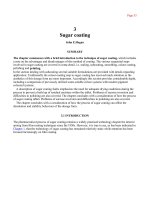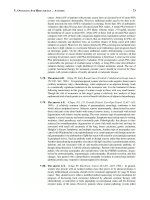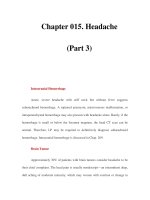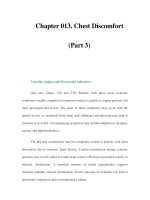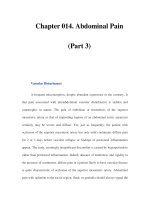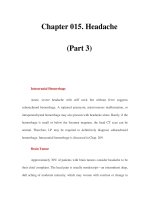Chapter 036. Edema (Part 3) pdf
Bạn đang xem bản rút gọn của tài liệu. Xem và tải ngay bản đầy đủ của tài liệu tại đây (45.21 KB, 5 trang )
Chapter 036. Edema
(Part 3)
Endothelin
This potent peptide vasoconstrictor is released by endothelial cells; its
concentration is elevated in heart failure and contributes to renal vasoconstriction,
Na
+
retention, and edema in heart failure.
Natriuretic Peptides
Atrial distention and/or a Na
+
load cause release into the circulation of
atrial natriuretic peptide (ANP), a polypeptide; a high-molecular-weight precursor
of ANP is stored in secretory granules within atrial myocytes. Release of ANP
causes (1) excretion of sodium and water by augmenting glomerular filtration rate,
inhibiting sodium reabsorption in the proximal tubule, and inhibiting release of
renin and aldosterone; and (2) arteriolar and venous dilation by antagonizing the
vasoconstrictor actions of AII, AVP, and sympathetic stimulation. Thus, ANP has
the capacity to oppose Na
+
retention and arterial pressure elevation in
hypervolemic states.
The closely related brain natriuretic peptide (BNP) is stored primarily in
ventricular myocardium and is released when ventricular diastolic pressure rises.
Its actions are similar to those of ANP. Circulating levels of ANP and BNP are
elevated in congestive heart failure and in cirrhosis with ascites, but obviously not
sufficiently to prevent edema formation. In addition, in edematous states there is
abnormal resistance to the actions of natriuretic peptides.
Clinical Causes of Edema
Obstruction of Venous (and Lymphatic) Drainage of a Limb
In this condition the hydrostatic pressure in the capillary bed upstream
(proximal) to the obstruction increases so that an abnormal quantity of fluid is
transferred from the vascular to the interstitial space. Since the alternative route
(i.e., the lymphatic channels) may also be obstructed or maximally filled, an
increased volume of interstitial fluid in the limb develops, i.e., there is trapping of
fluid in the extremity. Tissue tension rises in the affected limb until it
counterbalances the primary alterations in the Starling forces, at which time no
further fluid accumulates. The net effect is a local increase in the volume of
interstitial fluid, causing local edema. The displacement of fluid into a limb may
occur at the expense of the blood volume in the remainder of the body, thereby
reducing effective arterial blood volume and leading to the retention of NaCl and
H
2
O until the deficit in plasma volume has been corrected. This same sequence
occurs in ascites and hydrothorax, in which fluid is trapped or accumulates in the
cavitary space, depleting the intravascular volume and leading to secondary salt
and fluid retention.
Congestive Heart Failure
(See also Chap. 227) In this disorder the impaired systolic emptying of the
ventricle(s) and/or the impairment of ventricular relaxation promotes an
accumulation of blood in the venous circulation at the expense of the effective
arterial volume, and the aforementioned sequence of events (Fig. 36-1) is initiated.
In mild heart failure, a small increment of total blood volume may repair the
deficit of arterial volume and establish a new steady state. Through the operation
of Starling's law of the heart, an increase in ventricular diastolic volume promotes
a more forceful contraction and may thereby restore the cardiac output. However,
if the cardiac disorder is more severe, fluid retention continues, and the increment
in blood volume accumulates in the venous circulation. With reduction in cardiac
output, a decrease in baroreflex-mediated inhibition of the vasomotor center
activates renal vasoconstrictor nerves and the RAA system, causing Na
+
and H
2
O
retention.
Figure 36-1
